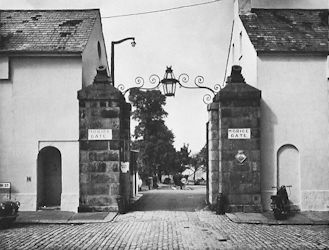|
OLD DEVONPORT
. UK |
||
|
© Brian
Moseley, Plymouth Webpage created: February 16, 2016 Webpage updated: October 09, 2022 |
||
|
GUN WHARF
The main gateway to the Gun Wharf was Morice
Gate, off
Ordnance Street, Devonport. While the South Yard was run by the Admiralty, the second part of the present Royal Dockyard was quite separate and in fact opened by the Ordnance Department. This was the Gun Wharf. Like that at Portsmouth, its purpose was to enable ships' guns tested by the Army's Board of Ordnance to be fitted to warships built or maintained within the Royal Dockyard and to supply them with munitions and equipment. A small gun wharf and storehouse had been established at Mount Wise shortly after the Dockyard came into existence. By 1717 it was inadequate. When the Navy Board heard about plans for a new gun wharf they asked for it to be nearer the Dockyard. Land was leased from Sir Nicholas Morice in 1719 and in due course the new yard was named after him. Jonathan Coad in his "Historic Architecture of HM Naval Base, Devonport, 1689-1850" tells us that the estimated cost of the work in November 1718 was £16,745 7s 3d. In the autumn of 1720 the construction contract was awarded to Mr William Cowley, stonemason, of London. He was later joined by Mr Abraham Curtis in respect of the carpentry and joinery. Although it is thought that Colonel Christian Lilly's plans of the yard may have been shown to Sir John Vanbrugh, Comptroller of the King's Works, there is no evidence of Vanbrugh's actual involvement so the styling of the buildings may be just an attempt by Lilly or his draughtsman, Schutze, to copy Vanbrugh's style. In January 1720 Mr Andrew Jelfe was appointed Clerk of Works. He appears to have designed the labourers' houses (later guard houses). Work started on site in 1720. A small powder magazine was included. In 1723 a Mr Jonathan Devall replaced Cowley as the stonemason. The Gun Wharf was partially operational by 1724. The powder magazine became too small and by 1730 the ships' powder was being kept in the Citadel and manhandled through the streets to the gun wharf, a highly dangerous practice. In 1743 the Board of Ordnance obtained permission for a new magazine, rubble-built with double skin walls and a barrel vault and bearing the arms of the Duke of Montagu, Master General of the Ordnance 1739-49. In the 1770s two new powder magazines and a shifting house were built at Keyham, closer to the powder mills at Saint Budeaux. A gas service was first installed to light the Gun Wharf in November 1846. The gas was supplied by the Devonport Gas and Coke Company from their gasworks just across the main road from the Keyham Steam Yard. In 1855 the Board of Ordnance was disbanded and its functions handed over to the War Department. An Army Ordnance Depot was created at Bull Point, in the parish of Saint Budeaux, which was at that time outside the Borough of Devonport. In the 1860s a new entrance to the Gun Wharf was built off New Passage Hill. This was known as the "North Gate". When wars were fought in distant lands, i.e. before the Great War of 1914-18, it use to be simple to gain access to the Gun Wharf by just asking the police at the main gate pictured above. Buildings within the Gun Wharf include the Armoury, which was used to hold large chests containing an immense collection of muskets, pistols, cutlasses and other instruments of destruction, with some of them arranged about the walls in star, circle, fan and crescent formations. On the wharves were cannons of all calibres from the ships moored in the Hamoaze. The Gun Wharf was transferred to the Admiralty in 1937 and but did not become a part of the Royal Dockyard until 1941, when it was given the name of Morice Yard. Details of the buildings listed under the Planning (Listed Buildings and Conservation Areas) Act 1990 and succeeding legislation is given in the Morice Yard section.
|
||
